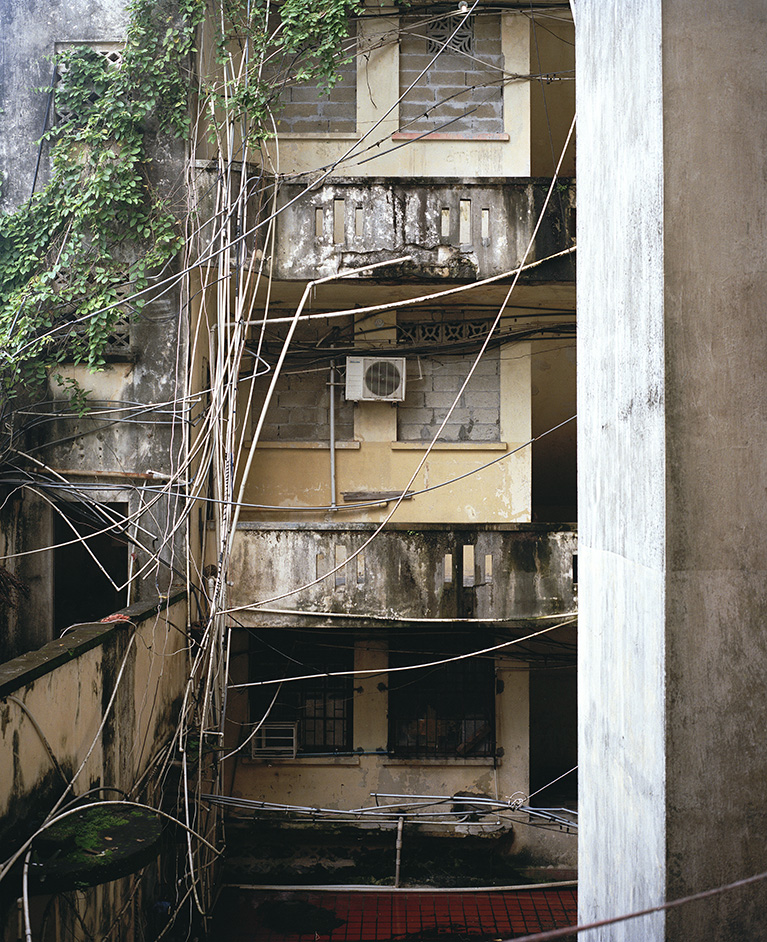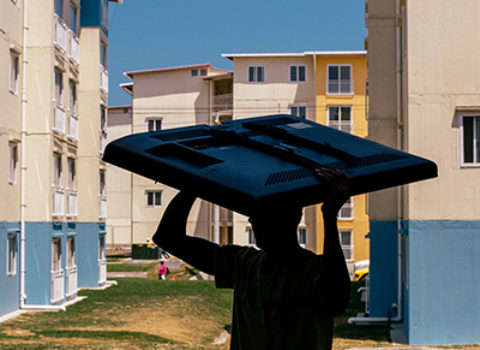God Is from Colón
A visit to the once-glamorous city of Colón. Photographs by Rose Marie Cromwell.
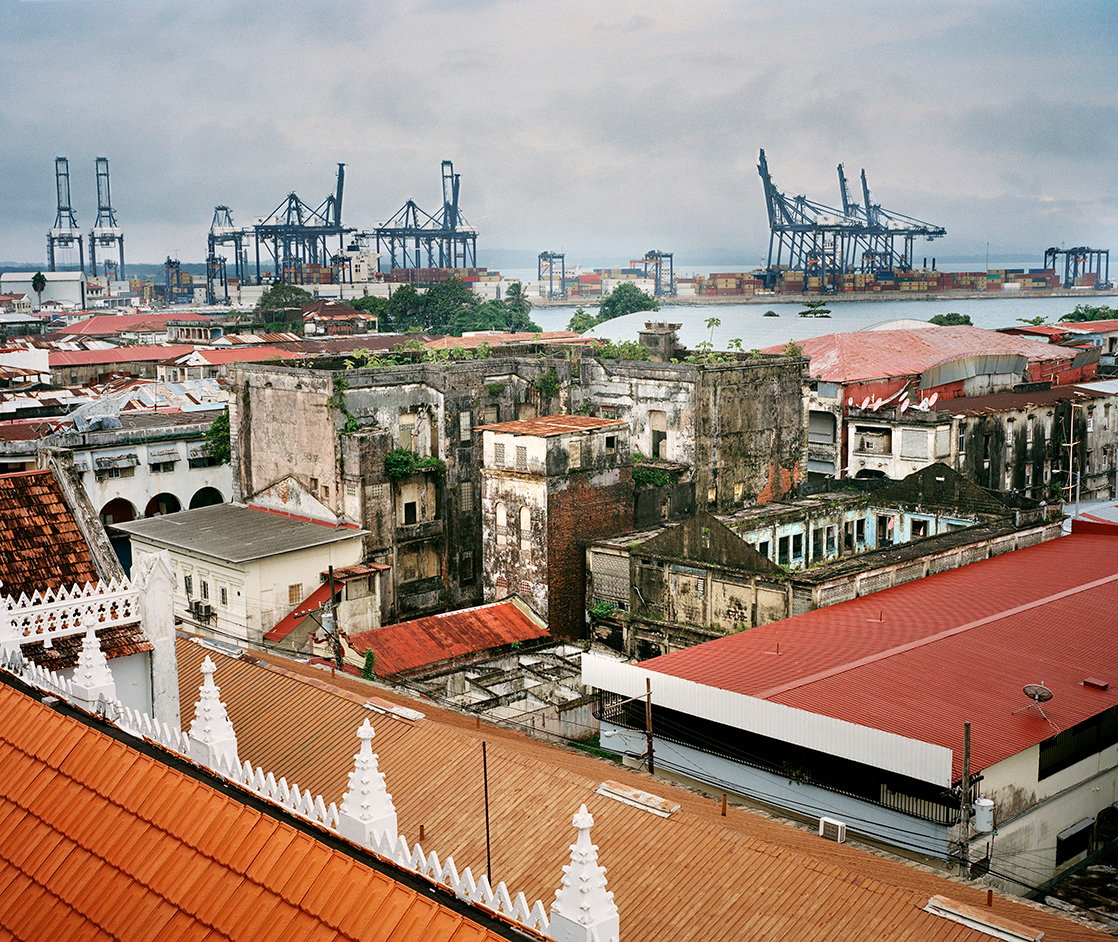
Colón seen from the tallest point in the city, the Colón Cathedral. In the distance, one of Colón’s ports are visible. Photographs by Rose Marie Cromwell
In many ways, the old Hotel Washington in Colón, Panama, is an apt metaphor for the city: its pioneering Spanish-colonial structure gives off a sense of its former glamour; the tall surrounding palm trees and seaside location evidence its tropical appeal; and the name “Washington” suggests its intimate historical connection to U.S. interests. Completed in 1913, it was for decades a popular destination for tourists and American businessmen. But today, with scrappy hedges and a saltwater pool, it offers little more than nostalgia for better days.
Growing up in Panama in the Nineties, my parents mostly spoke about Colón in the past tense: they referred to excursions with their families when they were children; they spoke about its great theaters and wide boulevards. But as they grew older, the reasons to visit Colón diminished, and increased crime and instability began to keep people away.
There’s a widespread sense in Colón that the world has forgotten it. Panama’s GDP has grown 7.89 percent over the last ten years, but many of the benefits have escaped the city. While Colón has a large free-trade zone, three commercial ports, and a new, luxurious cruise-ship marina—which all contribute significantly to the national economy—locals feel untouched by the capital coursing through; they live in dilapidated structures, often without running water or basic sanitation infrastructure. Colón’s unemployment rate, at 10.7 percent, is almost double that of nearby Panama City.
In 2014, the Panamanian government, seeing potential for tourism in Colón’s rundown architecture, ports, and proximity to Panama City, made the largest commitment to date to the city’s rehabilitation, in the form of a 500-million-dollar investment pledge. It was one of the bigger campaign promises of president Juan Carlos Varela, whose victory over incumbent president Ricardo Martinelli’s handpicked candidate was celebrated as a triumph of democracy. Part of Varela’s plan for Colón is an initiative known as Barrios Seguros—Safe Neighborhoods. It is, in rough strokes, and effort to address the high levels of violence caused by a deep-rooted gang problem, and, in doing so, incentivize the business sector to bet on Colón (among other locations where the program was also implemented).
The proposition struck me, having been raised in Panama, as somewhat radical. Outsiders today are rare in Colón and only occasionally do tourists venture past the port, often with a paid local guide for protection. But with the recent opening of the expanded Panama Canal—which accommodates larger, so-called post-Panamax ships in a brand-new third set of locks—and roughly a year into the Varela presidency, I was curious to see if things had changed.

At the time we met, these two young men, members of the Demon Black gang, here were set to start the professional training a week later.
The drive from Panama City to Colón is a fast hour thanks to a new highway, completed in 2012, which provided a much-needed alternative to the congested old Transístmica road. The freeway runs more or less parallel to the Panama Canal and is flanked by thick rainforest until signs of the metropolis begin to appear the closer you get to the Pacific coast. Toward the historic center of Colón, the highway leads you past the enormous, pastel-hued shopping complex of Cuatro Altos onto an overpass that descends gently and merges into Colón’s main avenue. This thoroughfare, a wide two-way street with a tree-lined center path known as Avenida Bolívarand further along as Paseo del Centenario, is flanked by colorful buildings, cheap stores, and sidewalks dotted with street vendors. People walk in every direction; young men wash cars with water from dirty buckets on the side of the road; old men sell lottery tickets outside the market; local ladies offer manicures in makeshift outdoor setups. The once-elegant edifices lining the main road are still attractive, though more in the way of a sour ruin-porn fantasy. (In a 2008 James Bond film, Colón was used as a stand-in for Haiti).

Joel Ceras has a masters in architectural history and heritage preservation, and was part of a team that prepared an in-depth architectural study of Colon’s buildings. His office is currently an dusty room inside a former high school school whose renovation he is supervising. The neoclassical building will serve as the Colon office of the Tribunal Electoral, the national body that oversees elections, organizes national censuses, and administers the Panama I.D. numbers assigned at birth.
One afternoon, Joel Ceras, a local architect and expert in restoring historical buildings, took us to see the rehabilitation of the Cinco de Noviembre park, where a group of young, tattooed men in reflective orange vests were at work with shovels in hand. Occupying a full block next to the city’s historic cathedral (itself on the last leg of a formidable renovation), the park is known locally as “La Concha” for its shell-shaped performance stage. During its renovation, workers discovered colorful tiles of the original fountain at the center of the park, dating to 1942. The young men at work were all part of the Barrios Seguros initiative. While somewhat tongue-tied, a few spoke to us, expressing enthusiasm about getting up in the morning and having something to do, to be going to work. They seemed relieved that they didn’t have to go far for work, or to have to cross through other parts of the city that might still be under control of other gangs. “I just roll out of bed, and five minutes later I’m at work,” said nineteen-year-old Sebastián Peña. Most of all, he said, he was excited to be working with friends.
In retrospect, it seems as if the cathedral across the street, and its white Madonna perched on the roof with her hand raised in the form of a blessing, were watching over the park and its young workers. Indeed, as Abelardo Muñoz, national executive coordinator of the program at the time I interviewed him, explained to us, faith is an important component of Barrios Seguros. The program is based on establishing trust between the city’s vulnerable youth, the Evangelical pastors, and the police. The spiritual aspect is crucial in Colón because the church has a strong presence in neighborhoods with gangs. “The boys respect them a fair deal,” said Muñoz, with some relief, referring to the pastors.
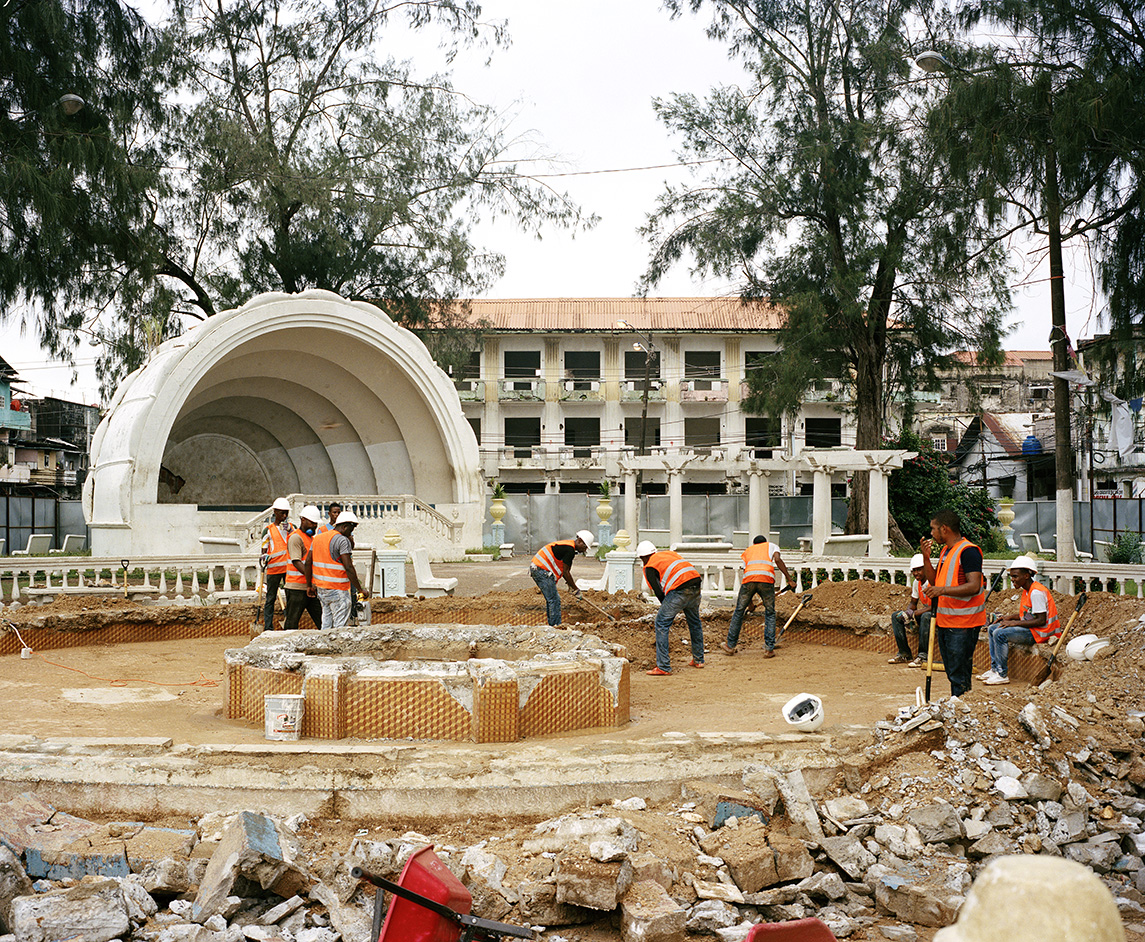
Occupying a full block next to the city’s historic cathedral, the November 5 Park is known locally as “La Concha” for its shell-shaped performance stage. While working on the renovation of La Concha, workers discovered colorful tiles of the original fountain at the center of the park, dating to the early 1942.
Part of the reason is that many of the Evangelical priests are former gang members. Rafael Cañas, a local Evangelical pastor, used to be in a gang himself. Today, he’s dedicated to working with the young men. “My experience, my life as part of a gang—that’s what’s motivated me,” he told us when we met on the Avenida Central one morning. “Society rejects these men; we offer them love.” He feels that the strongest points of the program are the economic and work components, as well as the spiritual dimension. He describes Barrios Seguros as a key partnership between the police, the government, and the church. (If someone who is part of the program is caught involved in any criminal activity, they are stripped of their privileges and sent to jail, few questions asked.) Mostly, Cañas feels that this program is a way to give hope to a group of people who’ve lost most of it. “People criticize that we’re supporting good-for-nothings,” said Cañas. “But whoever says that hasn’t had the opportunity, hasn’t had their child in a gang.”
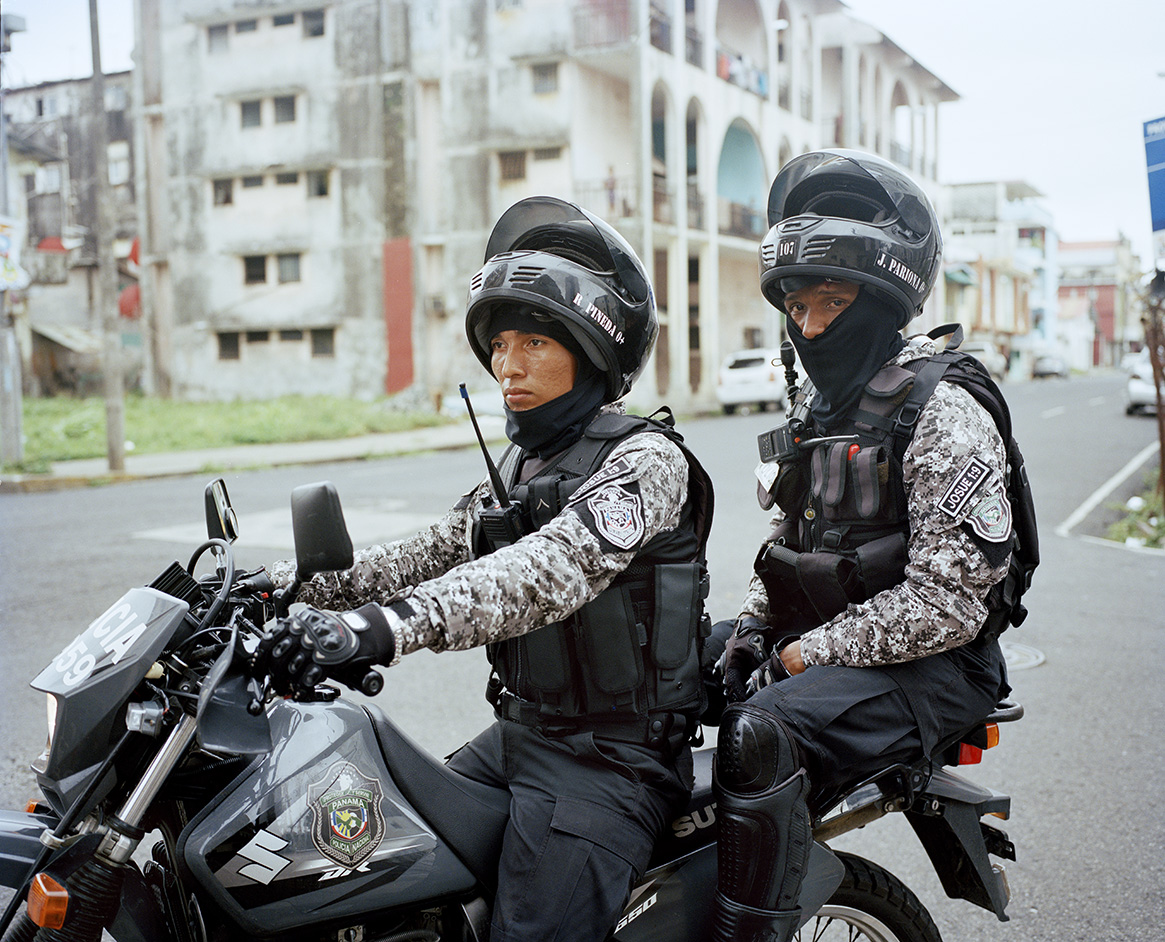
Colon has a strong police presence, and the officers’ cooperation is crucial to the Barrio Seguro program.
I met Moisés García one morning on the leafy center path of the Paseo Centenario avenue. He and a handful of others were waiting to start work, cleaning up and repainting this section of the park. García told me that he became part of the gang world when he was sixteen. Now he’s thirty-nine, has a three-year-old son and a fifteen-year-old daughter, and is part of the Barrios Seguros program. Colón was a city so violent that “you couldn’t cross from one area over to the next,” he told me. “Having nothing to do breeds laziness, and laziness breeds criminality.” He recognizes the government’s support in finding work. “You’d go to the Zona Libre [Free Trade Zone] or to a store, and you wouldn’t have a chance at a job. This program has raised my self-esteem. Before, I mostly thought about selling drugs.” He shares the widespread feeling that governments came and went and didn’t hold up their promises. “The violence was crude here,” he said. “Fifteen- and sixteen-year-olds dead in the street. Now I feel the government is doing it. . . . It’s less a sponsorship and more a breath of encouragement. And everything changes when you have a job: the way you live, the way you dress, the way you live in your home.”
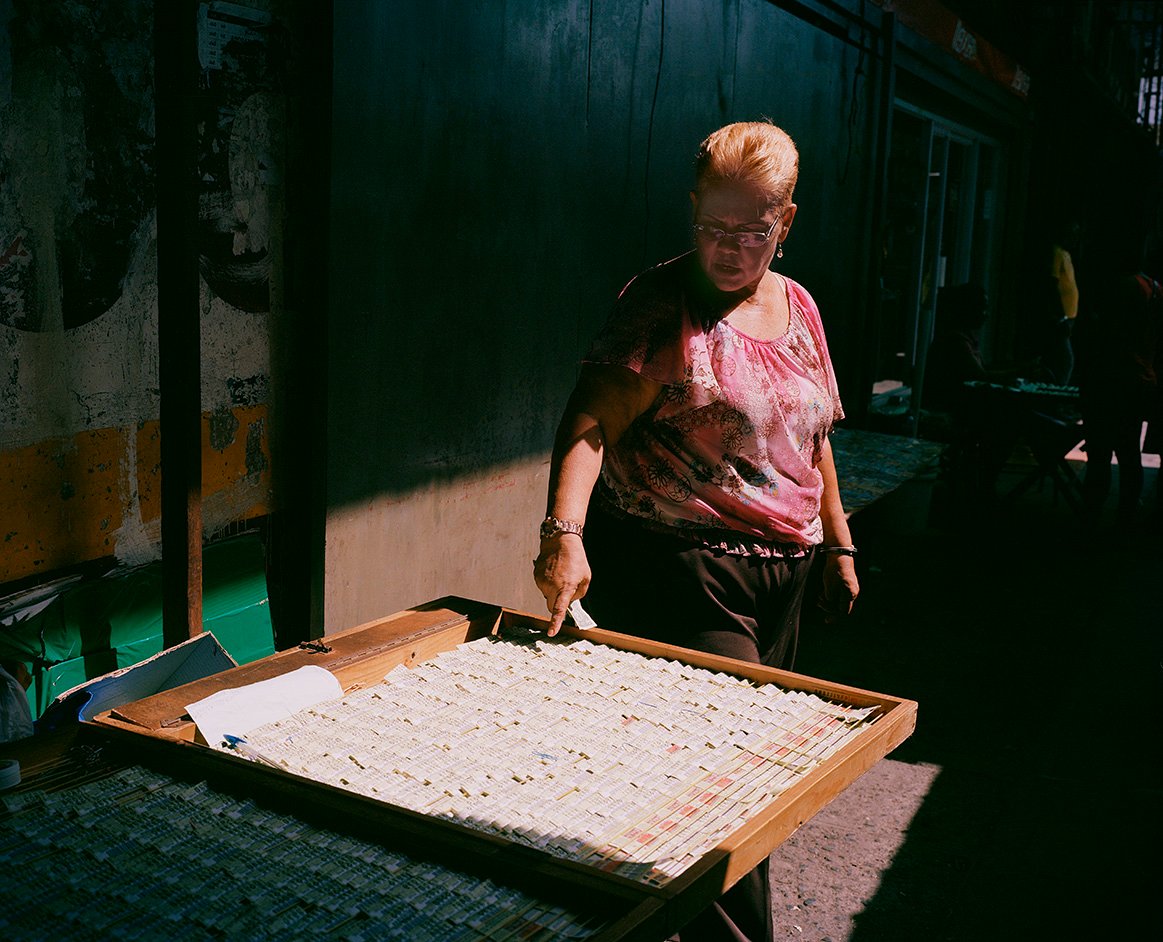
Lottery vendors are ubiquitous in Colon, with three or four outside parked outside each grocery store.
According to a report publishing last May, 4,150 people joined the program between its inception in August 2014 and January 2016. Of those, 1,200 completed the program successfully. In Colón, there were around 800 young men signed up, and at least one hundred successfully completed it. Crime statistics indicate a national decrease in violent crimes, and many ascribe the significant dip to the change in Colón, one of the country’s most violent cities. The Panama newspaper El Siglo reported in 2015 that crime had gone down 21 percent nationwide from 2014—but 58 percent in Colón.
“Generally they say that the boys are not going to change, that we should be taking harsher measures, which I completely argue against,” Muñoz, the former national coordinator, explained. From a numbers perspective alone it doesn’t make sense, he said. “We spend 12 million on the program every year. Less money is spent on prevention than on penalization. For example, the approximate cost of an inmate in a Panamanian jail is $9,000 per year, and with judicial processes prior to trial going up to three years, that’s $27,000 per person. If you had a thousand gang members in jail at that cost, that’s 27 million dollars. We spend 12 million preventing those boys from going to prison. That’s savings of 13 million dollars.”
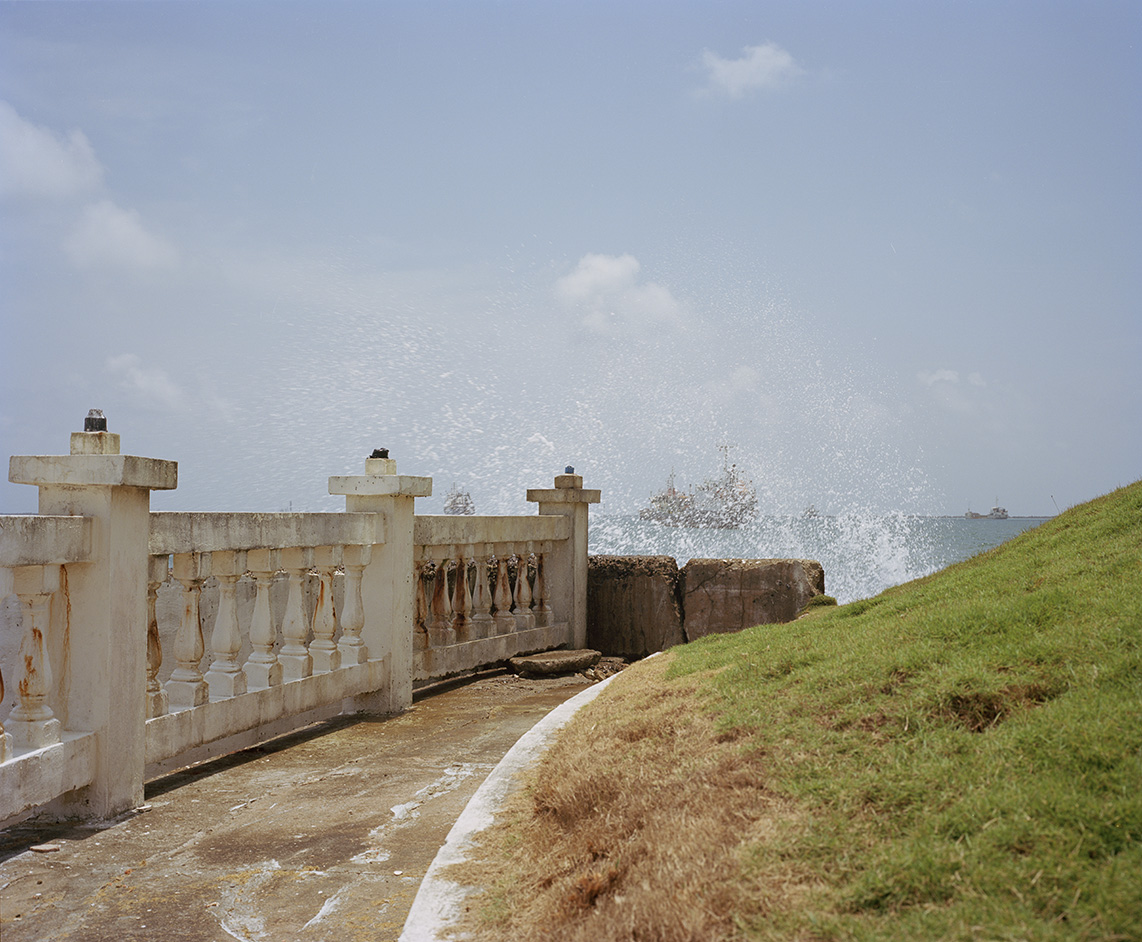
The seawall behind the Hotel Washington. In this distance, container ships line up to enter the Panama Canal.
The hopes to restore Colón not only as a cultural destination but also as a thriving port resonate even more when considered in light of the city’s history. Originally referred to by Americans as “Aspinwall,” after the U.S. railroad magnate William H. Aspinwall, the city was founded in 1850 with the construction of the first Transisthmian railway, which became instrumental to the California gold rush traffic. The railroad provided East Coast travelers a safer travel option than to cross the U.S. by land. It made use of an existing network of mail ships, led by the U.S. Mail Steamship Company, which sailed between New York and the Atlantic coast of Panama, and, on the other side, between Panama City on the Pacific Coast and San Francisco. In the late nineteenth and early twentieth centuries, Colón housed thousands of Afro-Antillean labor migrants arriving in Panama to work on the railroad, as well as Canal workers. A mix of low-income laborers, merchants, and foreign tourists, Colón was the virtual opposite of the orderly Canal Zone. As literary historian Jennifer Brittan put it, the city was “a reverse Tower of Babel, drawing in such a range of languages and dialects that the canal’s promise of regional coherence [coincided] with the creation of a profound linguistic confusion.” A comprehensive historic and architectural study of Colón led by architect and art historian Eduardo Tejeira in 2011 paints Colón’s population around the 1930s as spectacularly diverse: there were Jews, Hindus, Germans, Italians, Spaniards, as well as Greeks and Armenians running businesses. The language on the street was English, with Caribbean inflection. During World War II, the United States sent tens of thousands of military personnel to Panama in an effort to protect the Canal, and Colón benefited spectacularly: businesses flourished by day, and bars and cabarets, like the popular Atlantic Nite Club, were all the rage
After the war, the city began to decline. Several earlier large fires had systematically halted Colón’s growth and weakened its infrastructure, and when the Canal Zone’s civil and military population decreased dramatically as workers were sent back to the States, local businesses began to suffer. The construction of a Panama-Colón highway in 1943 and the move of several large factories to Panama City began to shift the center of gravity, which was only heightened with the rise of air travel that made Panama City’s Tocúmen Airport the main point of entry for travelers. Poverty and unemployment reached a nadir in 1959, when 5,000 people walked from Colón to Panama City in what was known as the March of Hunger and Desperation. Further unrest was compounded with the Panama City riots in January 1964, following the internationally covered flag incident, in which Panamanian students were shot by the U.S. military when they attempted to plant a Panamanian flag alongside the American flag in the Canal Zone. The already weakened infrastructure continued to deteriorate, and those who could afford to move to Panama City progressively left Colón. The situation got worse throughout the military dictatorships of Omar Torrijos and then Manuel Antonio Noriega, between 1968 and 1989. While the subsequent governments of Endara, Pérez-Balladares, Moscoso, Torrijos, and Martinelli all vowed to help Colón, the efforts were woefully insufficient.
Today, Colón is beautiful in a bygone kind of way, like an old actress who used to bring men to their knees but now drinks by herself, blowing cigarette smoke into the tropical night.
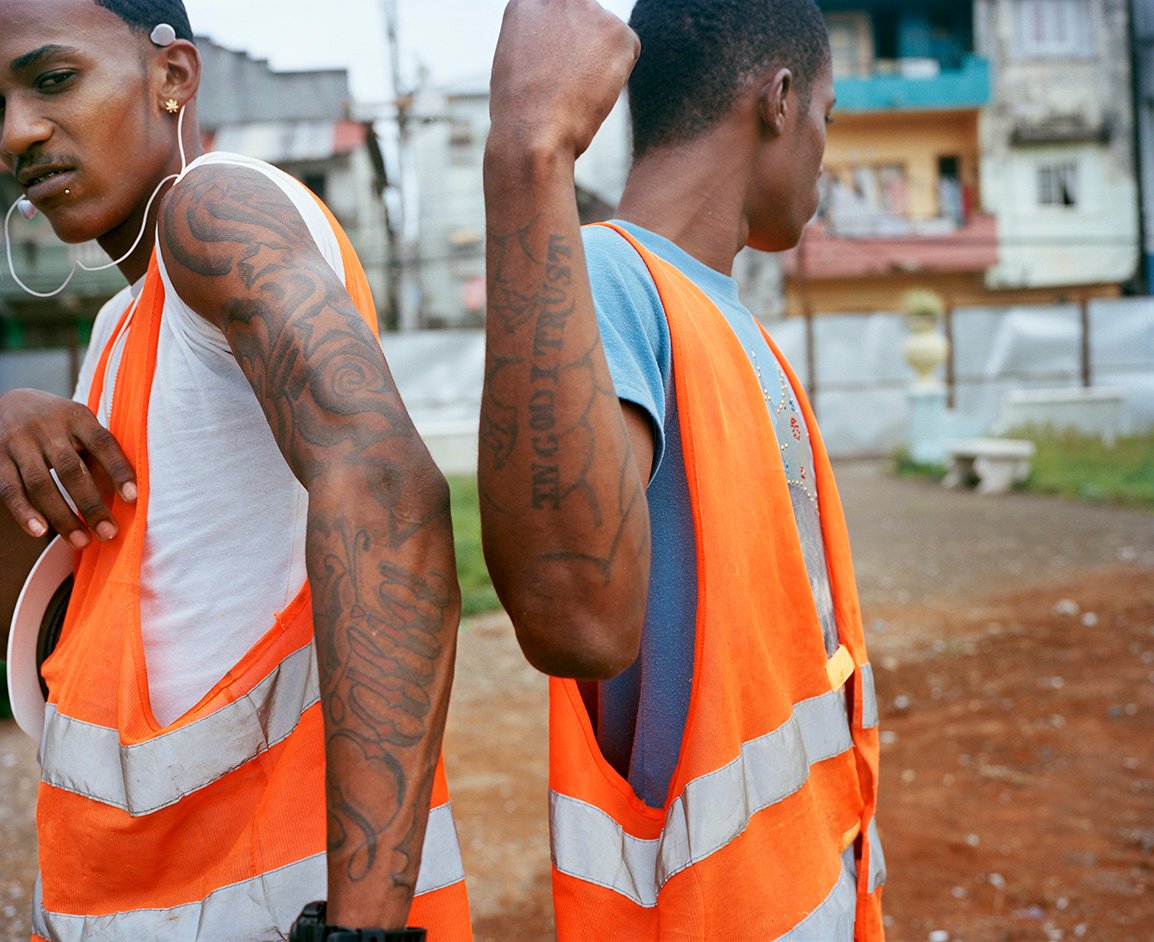
Young men on their first day working as part of Barrio Seguro. They are attempting to leave gang life behind, but their tattoos assert the difficulty of extricating themselves from this life.
On a Sunday morning near the church of San José, in central Colón, I waited for Suany Sánchez, one of the social workers deeply involved with Barrios Seguros. An early service had just let out, and the usually bustling corner was strangely quiet. Her boyfriend dropped her off in his taxi; she apologized for her delay, blaming it on a wedding the night before. At thirty-something, Sánchez is half a sister, half a mother to the young men in the program, youthful enough to earn their trust, but also sassy, confident, and direct enough to act as an authority figure. She seemed well known and liked in Colón; wherever we walked, people would call out her name or wave. And Sánchez, in turn, knows hundreds of the young men in the program by first name, as she advises them on the advantages of joining it and leaving a violent lifestyle behind. She can recite the names of all the gangs (Patio Limoso, Ratbat, etc.) and what city blocks they control or used to control—a very specific cartography fraught with peril.
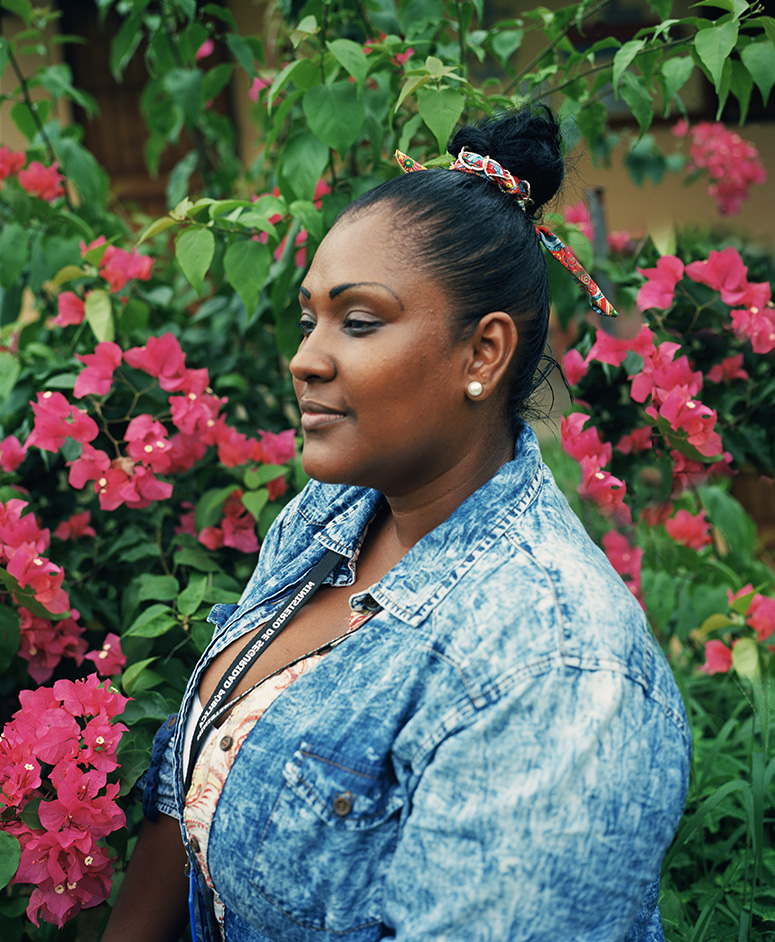
Suany Sanchez is a gutsy local community worker involved with the Barrio Seguro program. Sánchez was a candidate, in the last national election, for local representative of the northern neighborhood of Colon.
Sánchez also knows that the success of the program may well determine her future success in politics, one she describes as very difficult, due to her working-class origins and the fact that she’s a black woman from Colón, suggesting to us that she couldn’t have the odds more stacked against her. We had seen old, painted endorsements of Sánchez across town, from the last election. I asked her why she wanted to go into politics. “There’s a lot to do for Colón,” she said to me. “When you come from a humble background, politics is the only way to do something for your people. But it’s difficult, as a woman.”
Given her deep involvement, Sánchez knows that the program is far from perfect. It offers opportunities to at-risk young men, but leaves women not directly involved with gangs on the sidelines. Sánchez described frequent encounters with young women who say to her, “Suany, what about us?” “One of the mistakes was that there was no filter,” she also said. “We accepted young men [into the program] who didn’t fit the profile of a gang member.” Referring to at-risk youth, she said: “They get absorbed by the system in the street, but they aren’t at the same level as the other guys. Perhaps they’ve not committed a crime, haven’t gone to prison, haven’t committed a robbery or a homicide, but they’re in the program to take advantage of the biweekly stipend.”
“If I have a kid who is fourteen and lives in a hostile environment but who is in school, has a parent who works, is responsible, plays sports . . . he’s at a different level, he needs other type of help. In that case, I refer them, I speak to the family members. . . but I tell them, ‘This is not for you.’ It’s not the same to have that fourteen-year-old kid with the profile of an athlete, as a fifteen-year-old who started smoking at age ten and is already onto crack, doesn’t know how to read or write, dropped out of school, has an addict for a mother . . . they’re two different things, they’re two different realities.”

This young man agreed to be photographed only from the back. He’s been a part of the notorious gang known as Demon Black. Different members of the gang have been working with Evangelical pastor Jesús Ceballos on joining Barrio Seguro program.
On one of the last days of summer, Sánchez took us to talk to some of the more reticent young men, of a notorious gang called Demon Black, who were on the cusp of joining the program. A group of about seven were working out on outdoor gym equipment that Evangelical pastor Jesús Ceballos had acquired for them, in the small entrance courtyard to a rundown, bright blue house. They seemed less innocent than the boys we’d spoken to at the park; their looks and body language, especially as they were working out, were fierce and determined, angry. We learned that most of them had already done time in jail, had sons and daughters around Colón, and were fiercely watched by the police. They distrusted the police but seemed cautiously optimistic about starting with Barrios Seguros. As we walked from the recessed house back to the street, passing underneath lines of drying laundry, trash strewn about the grass, and palm trees heavy with ripe plantains, Ceballos reminded us that this reticence is not unusual. Speaking about another group of men, he said, “At the beginning, they didn’t want to participate. But with time they’ve seen how the program has developed, and that we’ve kept up our part of the agreement. Faith is the most important part because they don’t rebel against god. God is from Colón.”


